MSW: You’re welcome! I’m happy to be featuring you again here on My Several Worlds. We had a terrific response to your article on Guanjiang Shou. Can you tell us a little about yourself? When did you first become interested in photography?
RM: In a Tainan coffee shop run by a Canadian photographer, I was mesmerized by the owner’s B+W photos of India and, on his recommendation, I bought the venerable Nikon FM2. That camera was later stolen from under my cot as I slept on a packed ferry in the Philippines and the second one plummeted to its death from my tripod a few years later. I still fantasize about those lovely, fully manual FM2s; they were simple, durable and reliable.
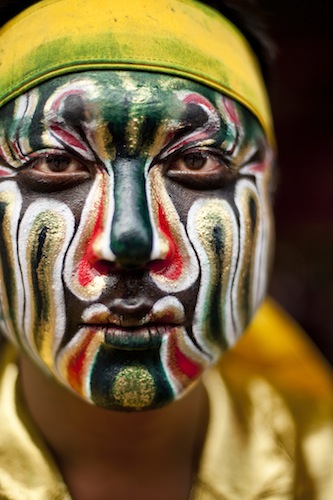
MSW: How did you get started in the business of photography?
RM: I’ve pretty much been boot-strapping my way in. I was first published in the China Post in the late 90’s to accompany an article written by long-time friend and writer, Steven Crook. From there I published sporadically as I continued to develop my photography. The now defunct South Magazine was great for developing editorial skills and Matt Gibson’s Xpat Magazine was a great outlet for creative work, but photography continued as a background income to teaching English.
After Typhoon Morakot in August 2009, my family’s plan of opening a small guesthouse on our land in the mountains was put on hold and we decided it was a good time to throw my lot in with photography. Two years on, I am starting to work out how to make a steady income but I still teach English two days a week for stability.
Recently, some work has started coming by way of the internet, and I have also lost some work when potential clients found my decidedly unprofessional blog. I have changed my blog format so potential clients know I am actually an able, working photographer. I am also struggling to get my archives online.

My favorite photos are the one’s that attempt to unmask the subject. Mexico, 2006
MSW: You’ve been living in Taiwan for many years now. What inspires your passion for this country?
RM: Taiwan’s great, it’s an ideal place for me. I love everything about this country; the geography, language, people, opportunities… Photographically, Taiwan is amazing. Remote mountains, rugged coastlines, colorful Aboriginals, hospitable locals, vibrant folk religions, tropical jungles and beaches, and high tech cities brimming with historical and cultural treasures; this small island has a bit of the best of everything. Further, for foreign English-speaking artists, the ability to pursue one’s passion while making a decent income teaching English is something I am grateful for.
MSW: How have your experiences in Taiwan affected you on a personal level?
RM: I’ve lived here for over half of my life so, for better or worse, Taiwan has made me what I am.
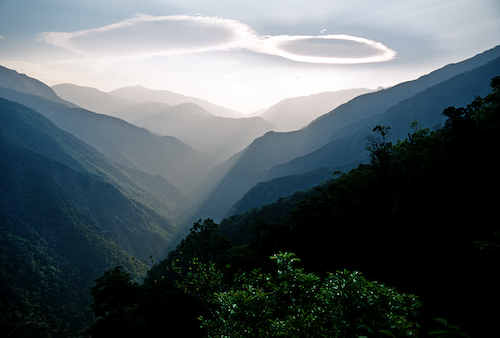 Southern Cross Island Highway: This photo was taken during a solo bike trip on a yet-to-be-paved South Cross Island Highway. No vehicles had been through for quite some time due to a landslide, but I was able to pick up my Taiwan bought Merida and carry it over the offending landslide. 1991
Southern Cross Island Highway: This photo was taken during a solo bike trip on a yet-to-be-paved South Cross Island Highway. No vehicles had been through for quite some time due to a landslide, but I was able to pick up my Taiwan bought Merida and carry it over the offending landslide. 1991
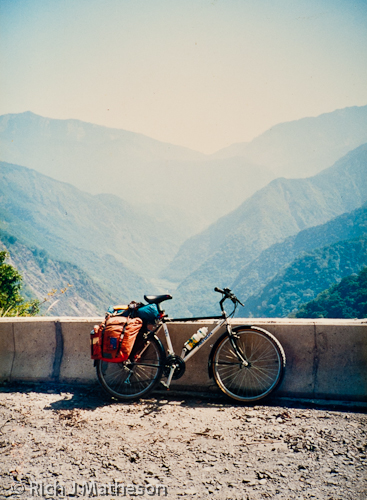 An older favorite. This place is special to me. I vividly remember a tiring ride up the South Cross Island Highway and arriving here for sunrise. I cracked a can of Mr. Brown as the sun gave theclouds a silver lining and bathed the misty drainage in a golden glow. A day of photography had begun. It ran as a full page lede for Steven Crook’s ‘Cruising East, across Taiwan’s South’, in Verve’s April 2002 issue –my first of three enjoyable South Cross assignments and one of many trips. Fuji Velvia and a horrible home scan, circa 2002.
An older favorite. This place is special to me. I vividly remember a tiring ride up the South Cross Island Highway and arriving here for sunrise. I cracked a can of Mr. Brown as the sun gave theclouds a silver lining and bathed the misty drainage in a golden glow. A day of photography had begun. It ran as a full page lede for Steven Crook’s ‘Cruising East, across Taiwan’s South’, in Verve’s April 2002 issue –my first of three enjoyable South Cross assignments and one of many trips. Fuji Velvia and a horrible home scan, circa 2002.
MSW: What kind of gear do you pack when you’re on the road?
RM: I’m partial to prime lenses. I’m never without a 50mm lens. I now have the Sigma 50mm F1.4 EX DG HSM which is not so compact, but still smaller than most zoom lenses. The D700 sensor coupled with f1.4 I can pretty much take a picture in the dark. The 50mm lets me get within an interactive distance with a person and covers any subject in a pinch. Otherwise, I have the Nikkor 105mm f2.8, which I really like. And I usually carry two zooms, one wide (Tamron 17-35 — remember, I’m boot-strapping) and one long (Nikkor 70-200mm f/2.8G ED VR — love it, but hate the weight). I still carry my heavy old tripod out of habit, but am using it much less nowadays. Finally, I carry speed-lights when needed.
MSW: What are your favorite photography web sites?
RM: I’ve followed The Online Photographer from it’s inception and I used to look forward to the weekly Sunday Morning Photographer (both Mike Johnston) on the Luminous Landscape site. It is well written, not always about photography and not too techie, so has never really bored me like so many other photography blogs and magazines tend to do over time.
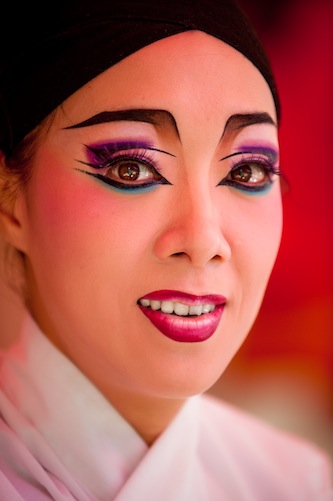
A current favorite. Her name is Little Dream and she kindly let me take photos backstage while she applied makeup. Nankunshen Temple, Tainan. June 2010 for Jiali’s Meifang Taiwanese opera troupe.
MSW: Do you have a favorite photograph from your collection? Any memorable travel moments you’d like to share with us?
RM: My favorite photographs are often not ones that resonate with other people, but ones where I had a personal connection to the subject, and of those I have many. In over twenty years, I haven’t yet begun taking my travel experiences for granted, I still find every encounter and experience memorable. I’ve gotten lost in a Sumbawan jungle, swum in Fraser Island’s glowing freshwater lake at night, slept atop Yushan in a lightning storm, been rescued after falling down a waterfall into a whirlpool cave in Kakadu Park and listened to barking deer yelping in the forest while sleeping under the stars on a sandy beach of the Nanzuxian River. But it’s usually all the little, unexciting things that make travelling great, like exploring an alley outside my house or being invited in for tea by a lovely Timorese family in Dili.
But, here is one story about me and photography:
I was just finishing up an assignment and wanted to get some more information about the Taiwan Literature Museum and free buses 88 and 99. I had the kids for the day (my own two and two of my wife’s nieces who live with us) and we climbed on the bus. The bus was great, but being a free tour bus, it was a long and circuitous route to the museum. I left the kids in the reading room and went to gather information. When I got back, my youngest was reading a large picture book — sitting in a puddle of pee. The workers were very gracious and helped clean the mess as I cleaned my son. We walked home rather than waiting for the bus and as we passed McDonalds, tired from a long day, I treated the kids to an ice-cream for putting up with me for the day. Later, when we finally got home, I realized that I had forgotten my camera gear at McDonalds. Thankfully, it was still there, the people sitting next to us had given it to the workers. When I told my wife about our day, she was relieved to hear that I hadn’t forgotten one of the kids in McDonalds. I think she was secretly happy to finally know what was more important to me, my camera or my children!
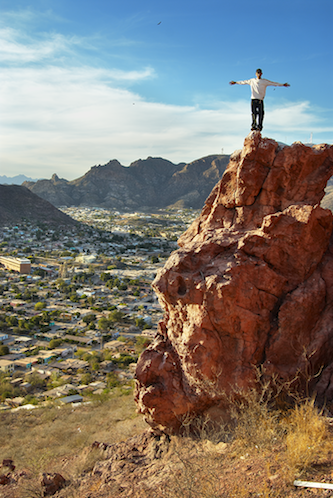 Another personal favorite because I had a connection with this young Mexican and his friends. Was scrambling up a peak and some local kids latched on to me and showed me some cool places. The kid in the picture clambered up this rock so I could take his picture. Without him it would be pretty mundane. Somewhere in Mexico, 2006
Another personal favorite because I had a connection with this young Mexican and his friends. Was scrambling up a peak and some local kids latched on to me and showed me some cool places. The kid in the picture clambered up this rock so I could take his picture. Without him it would be pretty mundane. Somewhere in Mexico, 2006
MSW: Your work has been featured in dozens of magazines and books. Can you tell us about your favorite photography assignment?
RM: My favorite assignment so far has been writing and photographing the Southern portion of the recently launched Michelin Green Guide, first edition. I had never written and photographed for such a large project and was initially daunted by the amount of writing and photographs needed in a relatively short amount of time. In the end, with so many years of exploring and learning about Taiwan, the hardest part was not in the amount of writing but rather deciding what to leave out. The editor and project manager were incredibly helpful and it was an amazing learning experience for me.
MSW: That is exciting! I can’t wait to read it. You are probably best known in Taiwan for your fantastic imagery of Taiwan’s folk religions. Can you tell us how you got into your niche?
RM: Thanks, I too consider this my niche. Unfortunately, I’ve yet to find a way to monetize this aspect of my photography, it is generally travel scenics and local color that I manage to sell. I began shooting nature/scenics on hiking trips in Taiwan and thought that was my strength. When I was putting an exhibit together I realized, much to my surprise, that it was my folk religion photography (with people in particular) that I was drawn to, and I ultimately find this more rewarding.
MSW: What are the most important qualities that a travel or editorial photographer needs to succeed? What advice would you give to aspiring photographers?
RM: If I ever find out, I will certainly let you know! I feel for photography in general, compassion with your subject is paramount. I attempt to treat subjects with respect and to be as authentic as possible, not strive for a romantic ideal, but more of a photojournalist/documentary approach. I never assume I understand some facet of Taiwanese life, but try to keep an open mind. It’s much more interesting that way; you don’t see what you want to see, rather you see what your subject wants you to see.
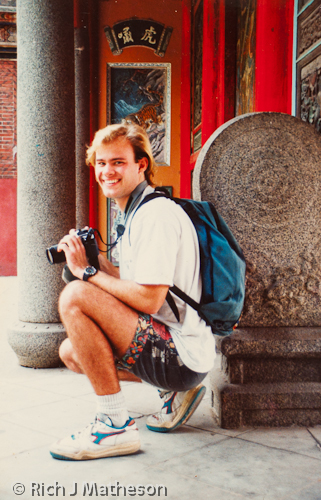
Me and my Nikon FM2, Kai Yuan Monastery. Tainan. 1991
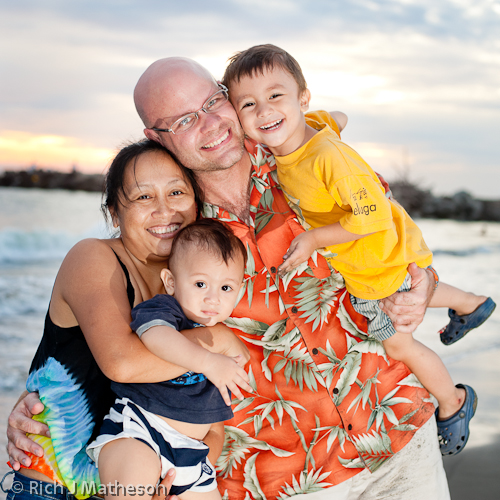 My family: Alas, Vaji and Vilian, Sz Cao Beach, Tainan. Sep. 2009
My family: Alas, Vaji and Vilian, Sz Cao Beach, Tainan. Sep. 2009

Canadian expat Carrie Kellenberger has kept a home base with her husband in Asia since 2003. A prolific traveler, Carrie has funded her travels primarily as a writer, editor, travel blogger and photographer, but she has also worked as an educator, voice over artist, model and nightclub singer. She draws upon her 15+ years of travel experience to write about travel-related issues and the countries she has visited on her award-winning web site, My Several Worlds.
Her photography and travel articles have appeared in both print and online publications around the world, including Travel and Leisure Asia, Unearthing Asia and Hip Compass Escapes.








